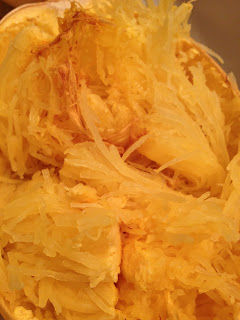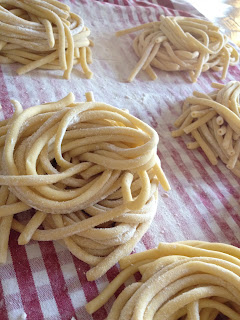In Chicago there are two ways to know it’s spring…the daffodils are blooming and the Lake Shore Drive bike path is full of clowns. For all of us christens, this means the Easter bunny will be arriving soon and for all of us foodies it mean that the most delicious bean of all has arrived in area markets…the Fava Bean.
Growing up in Poland, my parents had a little vegetable stand at a local indoor market. Before I was old enough to go to school, my parents would let me take my afternoon naps on the empty wooden cases at their stand. Springtime always meant bountiful supplies of leeks, asparagus and fava beans. (This was the mid 1980’s in the midst of the Solidarity Movement. Nothing was bountiful but somehow my parents were always able to stock their stand with the freshest and most in season veggies.) During these times, my entire family would spend our evenings sitting around the bowl waiting for my mom to fill it with peeled and blanched favas. As soon as a fresh batch hit the table we would race to peel off the thick skin so they wouldn’t burn our hands, devouring them instantly.
Although snacking on Favas brings back fond memories, lately I have been experimenting with some recipes. Below you will find two great dishes that work very well together. For each of these recipes the favas should be peeled and blanched before adding them to the dish.
 |
| Unpeeled Fava Beans |
Prepping the Favas (For both dishes)
1lb of fresh favas
1 teaspoon of kosher salt
Boil about two cups of water. While waiting for the water to boil, peel the fava beans from the green pods.
 |
| Shelled Fava Beans |
Salt the water and boil the Favas for about 5 minutes. The skin will turn from green to white. Using a slotted spoon rescue the Favas from the boiling water and immediately place them in ice water. This will stop the cooking process. After 5 minutes of soaking in ice water, remove the favas and recruit a sucker to peel them. J These will keep in the frig for a couple of days.
 |
| Peeled Favas |
 |
| White skin of Favas |
Grilled Lamb with Fava and Heirloom Tomato Relish
4-5 lbs of Boneless leg of lamb*
½ cup of coarsely chopped parsley
4-5 large cloves of garlic
Kosher Salt
Course ground pepper
Juice of ½ a lemon
2 tablespoons cider vinegar
2 tablespoons of regular olive oil
Lamb Prep
Trim excessive amounts of fat off of the leg of lamb. Some fat is good because it will naturally baste the lamb as it grills; so don’t go nuts with the miracle blade. Crush 4-5 garlic cloves and combine them with chopped parsley, cider vinegar, the juice of half a lemon and regular olive oil. Spread the mixture onto the lamb and allow the lamb to marinate overnight. Make sure to give it a turn at least once.
Grill the lamb at medium heat till it is medium rare or reaches an internal temp of 130-140. Allow the lamb to rest for at least 10 minutes before slicing.
Fava Heirloom Tomato Salad
3 colorful organic Heirloom Tomatoes
1 cup of prepped Fava Beans
1 sprig of chopped basil
Juice of ½ a lemon
1 tablespoon chopped red onion
1 tablespoon of high quality extra virgin olive oil
Cut up large heirloom tomatoes into 1 inch squares. I found some really ripe ones at Whole Foods. I like a lot of color so I made sure to choose one orange one, one green, red etc. In a bowl, combine the finely chopped red onion and tomatoes. Season with a bit of kosher salt and allow the juices to render through osmosis(remember Bio?). This will take about twenty minutes but will yield the most flavorful juice you have ever tasted. Add the Fava beans, lemon juice, extra virgin olive oil and season with fresh ground pepper.
I served the lamb on a bed on the fava tomato salad. The juice from the lamb combined with the tomato juice to make a heavenly sauce I could drink as dessert.
The Fava feast continues with a delicious Fava, Baby Spring Onion and Pancetta Pappardelle. I chose to make my own pappardelle using Ethan Stowell’s recipe substituting ½ cup of 00 flour with whole wheat flour. If you don’t have the time or patience, dry pappardelle or store bought fresh would work.
Ethan Stowell’s New Italian Kitchen Pasta Recipe
4 egg yolks at room temperature
4 cups of 00 flour
2 tablespoons olive oil
½- ¾ cups of water
In a food processor combine flour, olive oil and eggs. Pulse together. Slowly begin adding water, pulsing in between additions. The dough is done once it has formed little pearls but has not come together in a ball. Pour out of food processor and kneed together for about five minutes. The dough will become soft and smooth. Wrap in plastic wrap for at least 30 minutes.
I rolled my dough with my kitchen aid pasta rollers and then cut it by hand.
Now, let’s talk pancetta. Love it cooked or even raw. Yes, raw. I never tried raw pancetta(till my visit to PQM) and I don’t even know if it’s safe? Recently a brand new butcher shop opened up in Chicago called Publican Quality Meats. It is an amazing little shop with great local meats and grocery items. They also have the most amazing bread in Chicago. The pancetta I use in this recipe is from PQM. Pancetta meaning “little belly” in latin is cured pork belly sometimes seasoned and typically rolled. PQM seasons their pancetta with an unbelievable combo. I know there’s pepper in there but I’m still trying to figure out the rest. Whenever I cook with it I can’t help but nibble on the raw pieces.
Fava, Baby Vadalia Onions and Pancetta Pappardelle
2 ½ inch cuts of pancetta, cubed
Greens & white tops of baby Vadalia Onions
Olive oil
Basil
Pecorino Romano
Goats Milk Butter (optional)
Start by combining the pancetta with a drizzle of olive oil on low heat. Once the pancetta starts to brown add some sliced Vadalia Onion tops and continue to sauté till the onions start to caramelize. Season with salt and pepper. Boil the pappardelle till it is al dente and save some pasta water to add to the sauce. Right before serving, add the prepped Fava beans and pappardelle to the pancetta onion mixture. Add about ½ a cup of pasta cooking water and gently toss the pasta with the sauce on low heat. Finish with a sprinkle of basil, some Pecorino Romano, fresh ground pepper and a drizzle of high quality extra virgin olive oil or a bit of goats milk butter.
*The leg of lamb from Publican Quality Meats











































